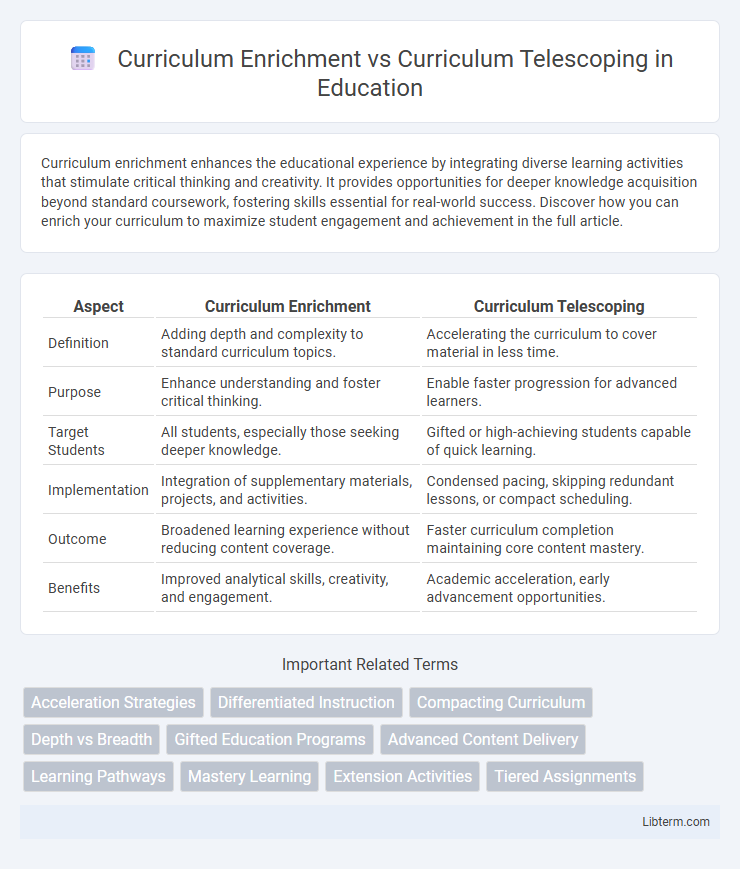Curriculum enrichment enhances the educational experience by integrating diverse learning activities that stimulate critical thinking and creativity. It provides opportunities for deeper knowledge acquisition beyond standard coursework, fostering skills essential for real-world success. Discover how you can enrich your curriculum to maximize student engagement and achievement in the full article.
Table of Comparison
| Aspect | Curriculum Enrichment | Curriculum Telescoping |
|---|---|---|
| Definition | Adding depth and complexity to standard curriculum topics. | Accelerating the curriculum to cover material in less time. |
| Purpose | Enhance understanding and foster critical thinking. | Enable faster progression for advanced learners. |
| Target Students | All students, especially those seeking deeper knowledge. | Gifted or high-achieving students capable of quick learning. |
| Implementation | Integration of supplementary materials, projects, and activities. | Condensed pacing, skipping redundant lessons, or compact scheduling. |
| Outcome | Broadened learning experience without reducing content coverage. | Faster curriculum completion maintaining core content mastery. |
| Benefits | Improved analytical skills, creativity, and engagement. | Academic acceleration, early advancement opportunities. |
Understanding Curriculum Enrichment and Curriculum Telescoping
Curriculum enrichment involves enhancing the standard syllabus with additional activities and resources to deepen students' understanding and engagement, often through interdisciplinary projects, real-world applications, and advanced content. Curriculum telescoping compresses the content of multiple grade levels into a shorter time frame, enabling gifted or advanced learners to progress faster by completing extensive material in fewer years. Both strategies aim to meet diverse learner needs but differ in approach: enrichment broadens learning experiences, while telescoping accelerates content mastery.
Key Differences Between Curriculum Enrichment and Telescoping
Curriculum Enrichment involves enhancing the standard curriculum by adding depth, breadth, and complexity to learning experiences, often through supplementary activities or advanced content that broadens students' knowledge. Curriculum Telescoping accelerates the content delivery by compressing the standard curriculum timeline, allowing students to complete the material faster, usually to challenge gifted learners or accommodate advanced pacing. Key differences include enrichment expanding learning opportunities without altering pacing, while telescoping maintains content scope but reduces the time for completion.
Goals and Objectives of Curriculum Enrichment
Curriculum Enrichment aims to enhance students' learning experiences by integrating supplementary activities and materials that broaden knowledge and foster critical thinking without altering the core syllabus. Its primary goals focus on deepening understanding, promoting creativity, and developing higher-order cognitive skills beyond standard curriculum requirements. Unlike Curriculum Telescoping, which accelerates content delivery, Curriculum Enrichment prioritizes holistic growth and intellectual engagement through diverse learning opportunities.
Purposes and Processes of Curriculum Telescoping
Curriculum telescoping aims to accelerate student learning by compressing the standard curriculum into a shorter timeframe, allowing gifted learners to progress at an advanced pace. The process involves selective content reduction, focused emphasizing of core concepts, and integrating higher-level cognitive tasks to maintain academic rigor while saving instructional time. This approach contrasts with curriculum enrichment, which broadens academic content without altering pacing or depth, focusing instead on expanding student experiences and knowledge beyond standard curricula.
Benefits of Curriculum Enrichment for Students
Curriculum Enrichment enhances students' learning by incorporating deeper, more complex content and diverse activities that foster critical thinking, creativity, and problem-solving skills. It promotes engagement and motivation by offering opportunities for exploration beyond standard grade-level expectations, supporting well-rounded intellectual development. Enrichment also caters to varied learning styles, encouraging personalized growth and a lifelong passion for knowledge.
Advantages of Curriculum Telescoping in Gifted Education
Curriculum telescoping accelerates learning by allowing gifted students to complete standard curricula at a faster pace, which enhances intellectual stimulation and maintains engagement. This approach provides opportunities for early mastery of advanced subjects, fostering deeper comprehension and academic challenge. By compacting content, telescoping supports personalized learning paths, reducing boredom and underachievement often experienced by gifted learners.
Challenges and Limitations of Curriculum Enrichment
Curriculum enrichment faces challenges such as limited classroom time and resource allocation, making it difficult to integrate supplementary content without overwhelming students or disrupting core learning objectives. Teachers may struggle with differentiating instruction to meet diverse learner needs while maintaining curriculum standards, which can impact the effectiveness of enrichment activities. Furthermore, assessment methods often remain focused on standard content, limiting the recognition and measurement of skills gained through enrichment programs.
Drawbacks and Concerns with Curriculum Telescoping
Curriculum telescoping accelerates student learning by compressing standard grade-level content into a shorter time frame, which can lead to gaps in foundational knowledge and increased stress due to the intensified pace. This approach often overlooks individual learning differences, causing some students to struggle with retention and depth of understanding. Concerns include potential burnout, reduced mastery of key concepts, and insufficient time for critical thinking and skill reinforcement.
Factors to Consider When Choosing Between Enrichment and Telescoping
Factors to consider when choosing between curriculum enrichment and curriculum telescoping include student readiness, learning pace, and depth of content engagement. Curriculum enrichment is ideal for students who benefit from broader, more diverse experiences without accelerating the grade level, supporting creativity and critical thinking. Curriculum telescoping suits advanced students ready for accelerated learning, enabling them to complete requirements faster while maintaining academic rigor and avoiding burnout.
Best Practices for Implementing Effective Curriculum Strategies
Effective curriculum enrichment incorporates diverse learning activities that go beyond standard objectives, promoting critical thinking and creativity in students. Curriculum telescoping accelerates content delivery, requiring careful pacing and differentiation to meet advanced learners' needs without overwhelming them. Best practices emphasize aligning enrichment and telescoping strategies with clear learning outcomes, ongoing assessment, and adaptive instruction to optimize student achievement and engagement.
Curriculum Enrichment Infographic

 libterm.com
libterm.com